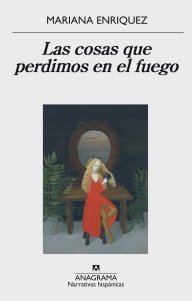Cross-posted from Posthegemony.
 Femininity is all too often defined by the image (and so by the male gaze). Women are reduced to appearance, and judged in terms of the extent to which they measure up to some mythical ideal. Mariana Enríquez’s short story, “Las cosas que perdimos en el fuego” (“Things We Lost in the Fire”), presents a surreal and disturbing counter-mythology that explores what happens when that image is subject to attack, not least by women themselves.
Femininity is all too often defined by the image (and so by the male gaze). Women are reduced to appearance, and judged in terms of the extent to which they measure up to some mythical ideal. Mariana Enríquez’s short story, “Las cosas que perdimos en el fuego” (“Things We Lost in the Fire”), presents a surreal and disturbing counter-mythology that explores what happens when that image is subject to attack, not least by women themselves.
It all starts with a woman who is compelled to support herself by begging on the Buenos Aires subway, after a jealous husband inflicts on her horrific burns that destroy her arms and face, leaving her with only one eye and a slit for a mouth, her lips burnt off. As she seeks contributions from subway passengers, she tells her story: that her husband threw alcohol on her face while she was asleep, setting her alight to “ruin” her, so she wouldn’t belong to anybody else. In the hospital, when everyone expected her to die and she couldn’t speak for herself, he said that she had done this to herself, a tragic accident after a fight. Now that she has recovered her voice, the woman on the subway reclaims her narrative and names the perpetrator. She knows, however, that she will never recover her appearance; her image was lost in the fire.
But perhaps it doesn’t all start there. As another character comments later, referring to a history of witch-hunts but also much more, “They’ve always burned women, they’ve been burning us for four centuries!” No doubt this is why the woman on the subway’s story starts to resonate so much with others.
First, it inspires copy-cat crimes: a model, who seems truly to incarnate that idealized image of femininity, is burnt by her footballer boyfriend in much the same way that the woman on the subway had been attacked. And he, too, blames her for what happened. As if it is only in death (the model does not survive her injuries) that women are granted agency, much like the famous if perhaps apocryphal witch-trials by water, in which only the drowned were presumed innocent.
Then, as Enríquez’s story progresses, small groups of Argentine women start to reclaim their agency while still alive, albeit by anticipating the torture inflicted on them by men. They begin to set light to themselves. Some do so alone, perhaps intending suicide. But, in the face of official disapproval, others form shadowy networks of “Burning Women” to aid and abet ritual ceremonies of self-immolation, complete with clandestine hospitals to ensure recovery thereafter. Because the point is to survive, and to put that survival on display. As one woman puts it: “They have always burned us. Now we are burning ourselves. But we’re not going to die: we’re going to flaunt our scars.”
The notion here is a kind of immunization: if women burn themselves, then they also rid themselves of the idealized image, the fetish that justifies men burning them. Moreover, they show that they cannot be reduced to appearances, albeit by paradoxically revelling in the way in which their new, “monstrous” appearance repels the male gaze. As the woman from the subway puts it, “Men are going to have to get used to us. Soon most women are going to look like me, if they don’t die. And wouldn’t that be nice? A new kind of beauty.” Laying claim to deformity, they challenge the gendered scopic regime of representation and power.
Yet this sacrificial logic is disturbing, and not only to men. The story is told from the perspective of a young woman, Silvina, whose mother is one of the first to throw herself into the campaign. It ends as she overhears her mother and a friend talking about her as a possible candidate for a burning: “Silvinita, oh, when Silvina burned it would be beautiful, she’d be a true flower of fire.” Here, the vision is (almost literally) of the Revolution eating its children, of a new image that ends up as horrific and coercive as the old one. The “ideal world of men and monsters” is no more (or perhaps no less) ideal than our own.
There are obvious resonances here with debates over the tactics of militant groups during Argentina’s Dirty War. There is also an explicit comparison to anorexia, which is also as much a self-destructive as a subversive mode of (re)claiming female agency. Perhaps, too, we might think of our contemporary immunological paradigm, and the price we are called upon to pay to confront all manner of diseases (metaphorical and otherwise). Fire both purifies and corrupts. Without nostalgia, and without any easy judgements, Enríquez compels us to think in new ways about what gets lost when we turn the tools that oppress us into weapons for liberation.
